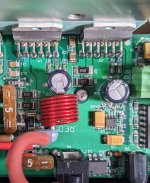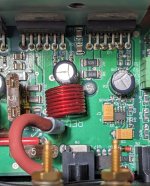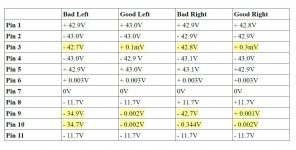First, I'm pretty green when it comes to chip amps, so expert help appreciated.
The amp in question is a Enlightened Audio Designs PowerMaster 500. The company is defunct, and I've not been able to locate a schematic or really much of any info about this amp, other than that it's 5 channel and uses two LM3886's per channel.
Four channels work fine, but when an 8 ohm dummy load is connected to channel five (no input signal), the current being drawn from the line goes from 800mA to about 2.5A and hangs there. Here are the voltages I can read from one of the two LM3886's for the bad channel (need to get a better needle point probe to safely reach the back pins):
Pin 1: +42.9V
Pin 2:
Pin 3: -42.8V
Pin 4:
Pin 5: +43.1V
Pin 6:
Pin 7: 0V
Pin 8:
Pin 9: -42.7V
Pin 10: -0.344V
Pin 11: -11.7V
The amp in question is a Enlightened Audio Designs PowerMaster 500. The company is defunct, and I've not been able to locate a schematic or really much of any info about this amp, other than that it's 5 channel and uses two LM3886's per channel.
Four channels work fine, but when an 8 ohm dummy load is connected to channel five (no input signal), the current being drawn from the line goes from 800mA to about 2.5A and hangs there. Here are the voltages I can read from one of the two LM3886's for the bad channel (need to get a better needle point probe to safely reach the back pins):
Pin 1: +42.9V
Pin 2:
Pin 3: -42.8V
Pin 4:
Pin 5: +43.1V
Pin 6:
Pin 7: 0V
Pin 8:
Pin 9: -42.7V
Pin 10: -0.344V
Pin 11: -11.7V
Yep, I'd already downloaded it earlier and took a brief spin through. I'll go through it more fully later. Thanks for the assist.
I'm immediately suspicious of >±42 V applied to the chip. ±42 V is the ABS MAX with signal applied.
Pin 9 is the inverting input. I'd expect that to sit around 0 V in an audio amp with bipolar/split supplies. But without a schematic it's hard to tell if it's by design. Unless there's a large coupling cap in series with the output I'd say the -43 V there is suspect.
V(pin 9) = V(pin 10) when the chip operates correctly and has negative feedback. That's the case for any opamp.
Tom
Pin 9 is the inverting input. I'd expect that to sit around 0 V in an audio amp with bipolar/split supplies. But without a schematic it's hard to tell if it's by design. Unless there's a large coupling cap in series with the output I'd say the -43 V there is suspect.
V(pin 9) = V(pin 10) when the chip operates correctly and has negative feedback. That's the case for any opamp.
Tom
Thanks Tom. I took some readings from a known good channel, and you're right that pin 9 should be around 0V. I've attached a comparison of voltages for the "bad" pair and good. So I have to figure out why I'm seeing - 43.0V on pin 9. I assume a short somewhere.
Attachments
Looks like some possible solder shorts between some pins of the right-hand amp.
No bridges--just artifacts from the lighting in the photo. There were, however, a number of cold solder joints, which I reflowed. No change in the issue. I'm going to take a look with a thermal camera.
Is there DC on the speakers outputs? I assume not, because the chip is probably in protection, but worth checking. Have you checked any of the SMD resistors right in front of pin 9 and 10? As well as checking the SMD capacitors by PIN 1 of the chip to check for shorts? What troubleshooting have you done other than checking voltage on chip pins? Check C5 and C7 since they are 35V caps, and you have already measured 42V on the chip?
I would start checking voltages on resistors and capacitors with a good channel and comparing for differences, which should you closer to the bad component.
I would start checking voltages on resistors and capacitors with a good channel and comparing for differences, which should you closer to the bad component.
Thanks. I should have mentioned that I had already checked and compared the resistors and caps, but in only part of the channel: Your post made me realize that I hadn't looked at anything closer to the left LM3886. While everything else has checked out fine, the Schottky diode at D8 is open. This is in series between the pin 3 output and the fuse, F3. And yep, I'm seeing -42.7V at the speaker terminals.


If fuse and diode are open, chances are the chip is dead.Thanks. I should have mentioned that I had already checked and compared the resistors and caps, but in only part of the channel: Your post made me realize that I hadn't looked at anything closer to the left LM3886. While everything else has checked out fine, the Schottky diode at D8 is open. This is in series between the pin 3 output and the fuse, F3. And yep, I'm seeing -42.7V at the speaker terminals.
View attachment 1146422
But remove the diode and check the diode
Also other diodes before you go and remove the chip
Looks like it is shorted. If they used 2 chips per channel both will need to be replaced.
If it is an input voltage, the - rail will be a lower voltage then the output as the chip loses 3 volts of rail voltage when driven.
43v rails are really high for this chip.
If it is an input voltage, the - rail will be a lower voltage then the output as the chip loses 3 volts of rail voltage when driven.
43v rails are really high for this chip.
Your amp uses two LM3886 in parallel and drives them at a voltage that is critically high. The worst I have seen in such an application were +-40volt. The LM has very good safety features build in, so you may get away with such a design. Anyway, the failure rate of the IC will rise considerably. At least that is what common knowledge predicts. Your amp from around 1990 may be close to 30 years old now, which can be seen as remarkable reliability of the original National Semiconductor, now TI, design and product.
So at least you need two new LM3886 and have to check any part near it before replacing them.
There is just one problem with your repair, the LM3886 is out of stock at any reliable source. The ones offered at eBay and aliexpress are 99,9% Chinese fakes. Some of these seem to work at lower voltages, but are not comparable to the real thing, as they do not have the protection features and much lower sound quality. They are not even copies of the 3886, as the Chinese can not replicate the real thing, but cheap, different amps inside. There may be some real LM's offered at ridiculous prices (the real part was about $7 each retail!) but even such expensive offers will be fakes in most cases.
With your amp, running on over voltage, they will not even last a second. Do not ruin your PCB by trying any of those!
The real LM is extremely robust. You can short the output even while playing music and it will not even care. Try this with a fake one and they are instantly gone. Can be considered the best "fake test". Also, if your speaker are large enough, sound quality will not degrade, even shortly before clipping. It is one of the best amps I know so far.
There is hope for a new production run of the LM3886 next year. I would carefully remove the two defective amp chips, check any part around it and use the remaining channels until real LM's are available again. Maybe then replace all of them, as the others have suffered over voltage just as long.
To make the whole amp more reliable, you could lower the voltage just a little, but that would require some more advanced skills. The maybe 8 watt you loose are inaudible, while life expectancy will rise exponentially.
So at least you need two new LM3886 and have to check any part near it before replacing them.
There is just one problem with your repair, the LM3886 is out of stock at any reliable source. The ones offered at eBay and aliexpress are 99,9% Chinese fakes. Some of these seem to work at lower voltages, but are not comparable to the real thing, as they do not have the protection features and much lower sound quality. They are not even copies of the 3886, as the Chinese can not replicate the real thing, but cheap, different amps inside. There may be some real LM's offered at ridiculous prices (the real part was about $7 each retail!) but even such expensive offers will be fakes in most cases.
With your amp, running on over voltage, they will not even last a second. Do not ruin your PCB by trying any of those!
The real LM is extremely robust. You can short the output even while playing music and it will not even care. Try this with a fake one and they are instantly gone. Can be considered the best "fake test". Also, if your speaker are large enough, sound quality will not degrade, even shortly before clipping. It is one of the best amps I know so far.
There is hope for a new production run of the LM3886 next year. I would carefully remove the two defective amp chips, check any part around it and use the remaining channels until real LM's are available again. Maybe then replace all of them, as the others have suffered over voltage just as long.
To make the whole amp more reliable, you could lower the voltage just a little, but that would require some more advanced skills. The maybe 8 watt you loose are inaudible, while life expectancy will rise exponentially.
Ok, so I removed the diode, and it measures fine out of circuit. Not surprisingly there was no change to the voltages of either chip. Reinstalled the diode and it measures as a short again. I'll begin the wait for a new LM3886 production run.
If you have hot tweezers I'd desolder the two resistors marked R39. That'll disconnect the output of one LM3886 from the other in the parallel combination. You then need to figure out if the LM3886 is causing the -43 V on the input or if that's the input circuit that does that. If the LM3886 is being provided with -43 V on the input something is toast in the input circuitry.
In a normal year I'd just say to replace the LM3886es, but the lead time on those is approaching two years so I'd do some debugging before sacrificing the LM3886es.
Tom
In a normal year I'd just say to replace the LM3886es, but the lead time on those is approaching two years so I'd do some debugging before sacrificing the LM3886es.
Tom
- Home
- Amplifiers
- Chip Amps
- LM3886: Troubleshooting Enlightened Audio Designs Amp

